 Walking on air, fairest of the fair, there she is… Miss Nude America. 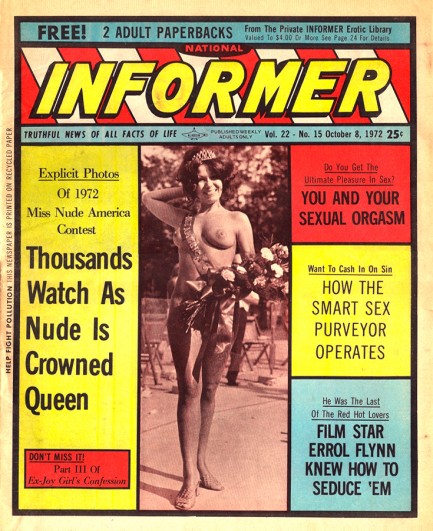
Our copies of National Informer span a time during which the paper was transitioning from typical tabloid to sex magazine. In our issues from 1966 to 1968, you get alarmist political journalism, which by the 1970s becomes drooling quasi-smut, as we see in this issue that first hit newsstands today in 1972. Of course, this shift from commie-baiting to masturbating meant abandoning a rightward leaning readership for a leftward leaning one. Clearly the move was meant to boost readership, but it didn’t work. It wasn’t Informer’s fault, though. All the old school tabloids were taking a beating. Even the venerable National Police Gazette, which had begun publishing lifetimes earlier, in 1845, died during the seventies. But Informer had a shorter history, a smaller audience, and a lower budget. In a tabloid sea where old battleships like Gazette and Confidential couldn’t turn quickly when the weather changed, Informer was a mere speedboat. Turn it did, and quite easily. Hugh Hefner’s Playboy had obliterated America's already battered pubic hair barrier in 1971 and Informer followed in its wake. But more explicitness did not bring more readership, as far as we can tell. National Informer and its sister publication National Informer Weekly Reader were dead by 1974. 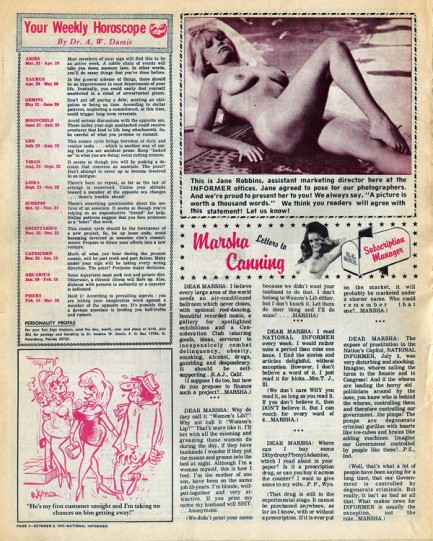 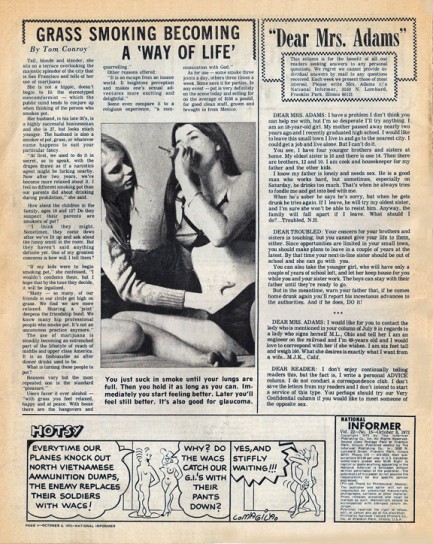 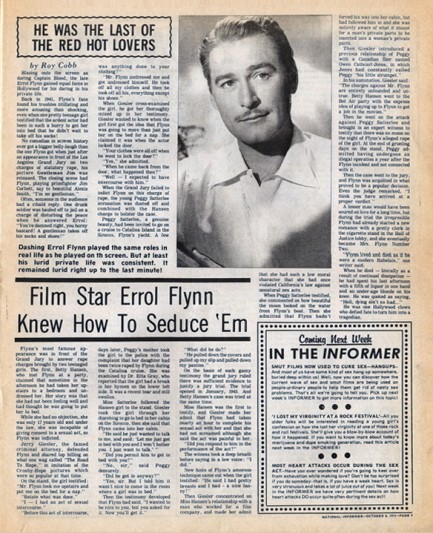  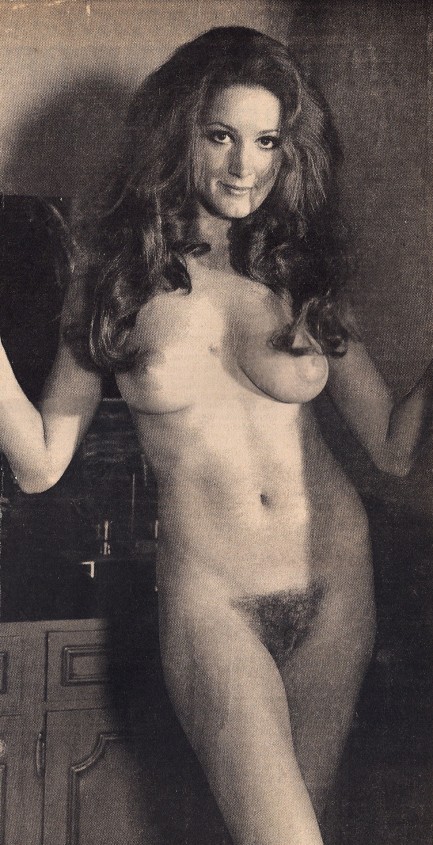 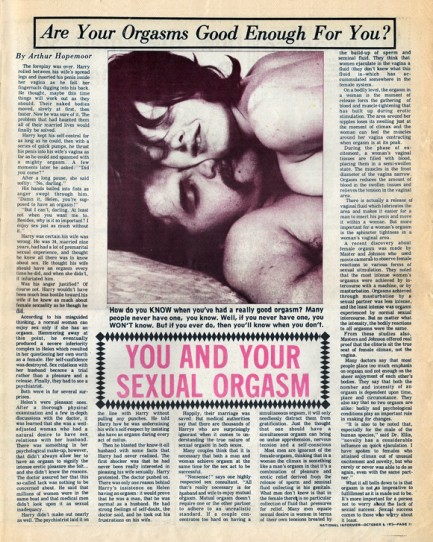 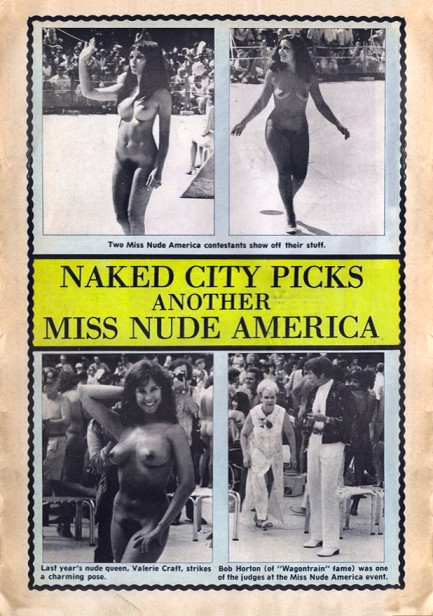 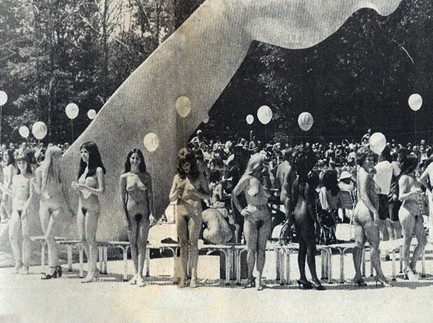 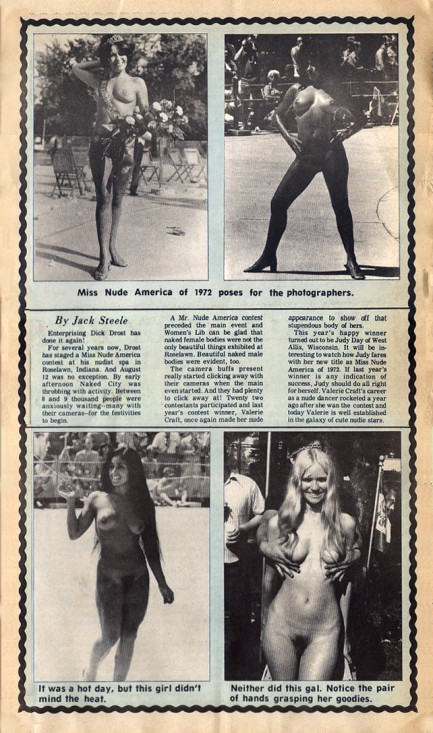 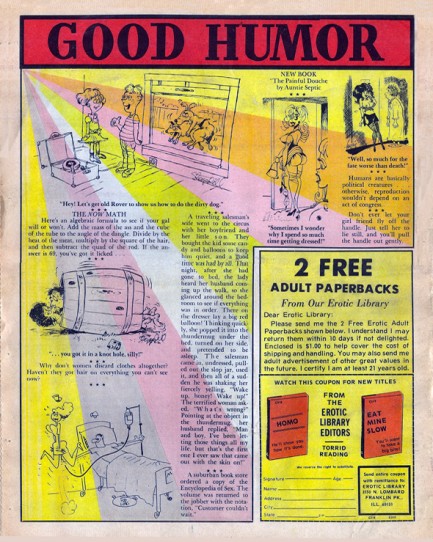
 I know why the caged Ladybug sings. 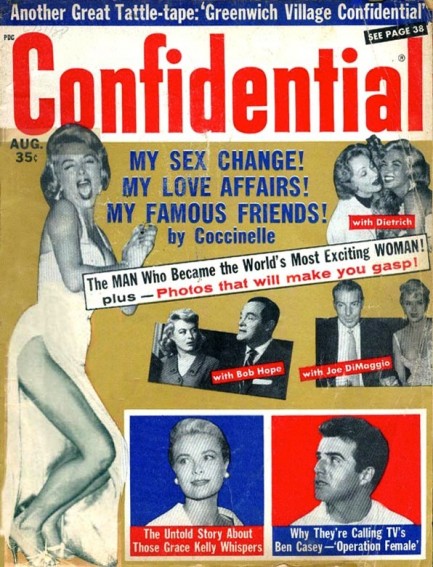
This golden issue of Confidential from August 1961 contains an article about the one and only Coccinelle, who was a French transsexual performer, almost forgotten outside her home country, but who set the world on fire fifty years ago. Born as Jacques Charles Dufresnoy, he adopted the stage name Coccinelle—Ladybug—in 1953 when he debuted at the nightclub Chez Madame Arthur. At the outset of his career, Coccinelle was a male cross-dresser, but in 1958 he underwent sex change surgery in Morocco with spectacular results, and her re-emergence onto the stage as a woman made her world famous. Adopting the persona of blonde bombshells like Mansfield and Monroe, she was able to parlay her status into film roles, and was also featured in a few shockumentaries, but it was on the stage that she shone, performing at some of France’s most exclusive clubs, including Le Carrousel and Paris Olympia. 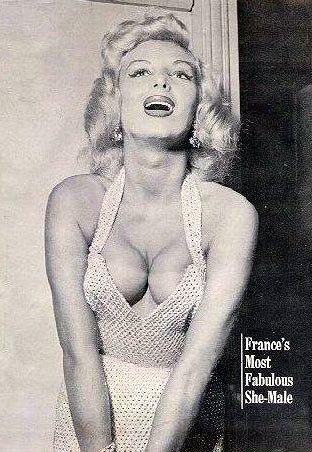 Her fame was a controversial subject of course, if not a public obsession, and her marriages caused epic scandals, but also prompted the French government to legalize unions between transgendered participants. By 1989 Coccinelle had moved to Marseilles, where she headlined at the Cabaret Spitz. She was still performing there in April 2006 when she had a stroke. She died after three months of hospitalization, but over forty years she had carved out a successful career, made a difference politically and, at the forefront of her own small sexual revolution, helped scores of people in her exact circumstances. We’ll look for more information on the fascinating Coccinelle at our usual French sources and perhaps report back on her later. Her fame was a controversial subject of course, if not a public obsession, and her marriages caused epic scandals, but also prompted the French government to legalize unions between transgendered participants. By 1989 Coccinelle had moved to Marseilles, where she headlined at the Cabaret Spitz. She was still performing there in April 2006 when she had a stroke. She died after three months of hospitalization, but over forty years she had carved out a successful career, made a difference politically and, at the forefront of her own small sexual revolution, helped scores of people in her exact circumstances. We’ll look for more information on the fascinating Coccinelle at our usual French sources and perhaps report back on her later.
 Here’s a cover I came across that I thought you guys would like. The header I wrote is the absolute limit of my cleverness, so no subhead, sorry to say. Feel free to add one. The year on this is 1968. Submitted by Will N. You’re right, we do like this. As far as adding to what you wrote, we could do it but that would defeat the purpose of us not doing any work on these. Regarding reaching the limit of your cleverness, you’ll notice that never stops us.
 Confidential tries a new look on the outside, sticks with the tried and true inside. 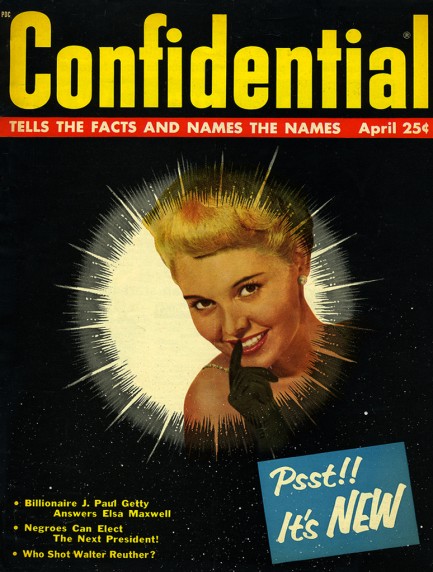
Here’s an unusual black Confidential from April 1958, which offers a mere trio of cover teasers. But the streamlined look outside doesn’t change the interior formula, which means you get the usual selection of dubious journalism, including a piece on black voter turnout designed to get white people seriously worried, and a story on CIO president Walter Reuther that emphasizes the possibility that he was shot by communists. But the most interesting story—to us, at least—concerns oilman/billionaire J. Paul Getty and gossip columnist/society hostess Elsa Maxwell, because the two well-known figures present an instructive lesson in contrasts. Getty came from a wealthy family; Maxwell’s humble background made her an intruder in high society. Getty was as vicious as a mongoose, but his wealth prevented what would have been a well-deserved fall from grace; Maxwell used pure charm and intelligence to rise to a position as the most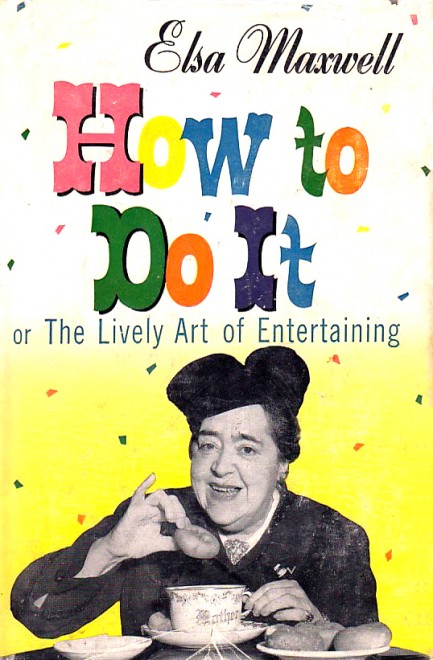 celebrated society hostess in the world. The worst Maxwell probably ever did was dish on society types in her gossip column; Getty once allowed kidnappers to cut off his grandson’s ear rather than part with a ransom, and once extended to Alfried Krupp von Bohlen—a German munitions baron who had given lavishly to the Nazi Party, used Jewish slaves in his industries during WWII, and allowed his factory yards to be used for executing POWs—an invitation to his house warming party. Advantage, Maxwell. One other thing in her favor—she’s the person the phrase “the hostess with the mostest” was popularized about. We’d take that as a legacy any day. celebrated society hostess in the world. The worst Maxwell probably ever did was dish on society types in her gossip column; Getty once allowed kidnappers to cut off his grandson’s ear rather than part with a ransom, and once extended to Alfried Krupp von Bohlen—a German munitions baron who had given lavishly to the Nazi Party, used Jewish slaves in his industries during WWII, and allowed his factory yards to be used for executing POWs—an invitation to his house warming party. Advantage, Maxwell. One other thing in her favor—she’s the person the phrase “the hostess with the mostest” was popularized about. We’d take that as a legacy any day.
 All of America seemed to want George Hamilton sent to Southeast Asia. 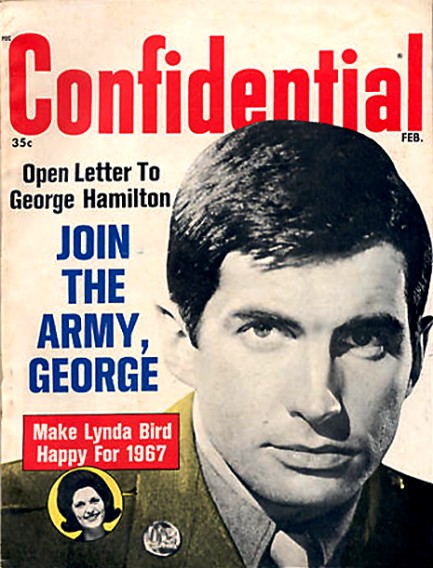
We’re doubling up on Confidential this weekend because we have so many. Here’s another February issue, this one from 1967, with an unusual white cover featuring actor George Hamilton. What was the big deal about him joining the army? Well, he was dating Lynda Bird Johnson, who happened to be the daughter of Lady Bird Johnson, who happened to be the wife of president Lyndon Baines Johnson. Pro-Vietnam War Confidential is urging him to prove to America that he was not passed over in the draft because of his connection to the White House. The idea of pressing for men such as Hamilton to be inducted also made sense to the anti-war left, which believed putting the scions of high society in jeopardy would hasten the end of the country’s Asian misadventure. You see that strategy being carried out below, by three members of the Ad Hoc Committee to Draft George Hamilton. We have no data on whether pushing for more upper class draftees hastened the end of the war, and we doubt any exists. But it’s true that minority participation and casualties fell as the conflict progressed—though the numbers didn’t shift as radically as many people think. end of the war, and we doubt any exists. But it’s true that minority participation and casualties fell as the conflict progressed—though the numbers didn’t shift as radically as many people think. As far as whether Hamilton’s relationship with Lynda Bird Johnson actually kept him out of Southeast Asia, officially at least, he was eventually passed permanently over because he represented the sole means of support for his mother. It's a reasonable sounding excuse—far more believable than the bunions, bone spurs, and other conditions suddenly suffered by the rich—but Confidential shreds Hamilton's deferral succintly: "As sole support of your mother you escaped the draft. Now you have $1,000,000, a Rolls Royce, and a 39-room house. So what's holding you back, tiger?"
 History depends on who’s doing the telling. 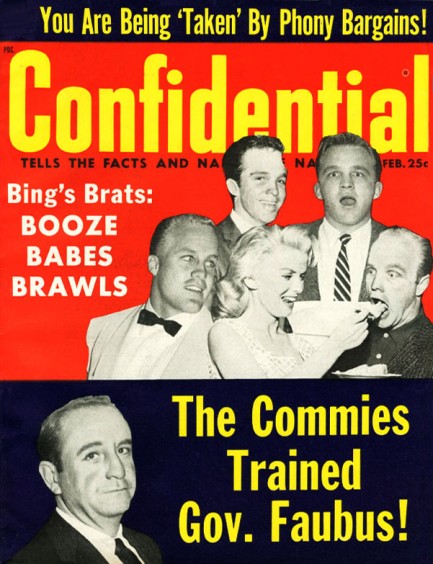
The above issue of Confidential is less visually chaotic than usual on the cover, but packs a wallop inside. The communist tag they’ve slapped on Arkansas Governor Orval Faubus stems from his having attended a leftist school. His political opponent in a 1954 election run-off tried to use it against him, but Faubus won anyway. In 1957, Faubus, at the time facing a serious primary challenge from an unapologetic segregationist, called in the National Guard to close high schools in Little Rock in an effort to prevent black students from attending them. The event made him, for a time, the face of the conservative South, as photos of Faubus speaking to crowds from the front stairs of Central High School circulated around the world. Two years afterward, in 1959, Confidential published this issue. So Faubus was branded a leftist, then a rightist. then a leftist again.
Some historians argue that Faubus, who had been elected student body president at that leftist school (Commonwealth College in Mena, Arkansas), harbored few if any racist beliefs, but by closing Little Rock high schools was merely trying to win an election by proving to the sizable racist electorate in Arkansas that, yes, he too could deny equal rights to African Americans. There’s also the question 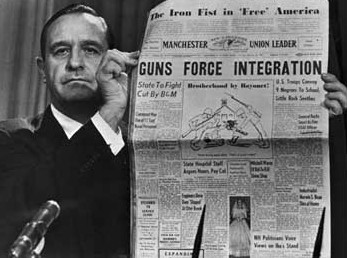 of whether he did it to prevent white mobs from taking violent action against black kids, since he had allegedly been convinced violence was imminent. And it could be argued that if his ultra rightwing rival had defeated him Arkansas would have been far worse off. of whether he did it to prevent white mobs from taking violent action against black kids, since he had allegedly been convinced violence was imminent. And it could be argued that if his ultra rightwing rival had defeated him Arkansas would have been far worse off. The first reading paints Faubus as an opportunist, while the second casts him as more of a good-intentioned pragmatist. Both speak to the reality of politics, where sticking to your principles becomes a dodgy proposition when doing it might cost your job. Viewed from the perspective of a black highschooler, any man who enforces the prevailing system of apartheid is a bad man—political realities nothwithstanding. There's no doubt that bowing to racists and fanatics is cowardly by any measure. So what was Faubus—the man—in the end? We may never know. But enough politics—the story that really sings here is the one on Bing’s brat pack. American crooner Bing Crosby’s four sons, all born in the 1930s, followed their father into show business and formed a vocal group called The Crosby Boys. Gary, Dennis, Phillip, and Lindsey performed at nightclubs and on the Ed Sullivan Show, but their careers never reached the heights of their father's, who sold something like five-hundred million records. Confidential tells stories of the boys misbehaving all over Hollywood and generally acting like spoiled kids with serious problems. The possible root of their troubles became public knowledge in 1983, when eldest sibling Gary Crosby wrote Going My Own Way, a biography of his now-deceased father that detailed mental and physical abuse—not just hide tannings of the type common in those days, but whippings that drew blood.
Needless to say, quite a furor erupted over the revelations. Even today, you can find apologist websites explaining that Bing’s childrearing techniques were not so harsh for the times, and attack websites that paint him as a murderous tyrant. Phillip Crosby disputed many of the claims in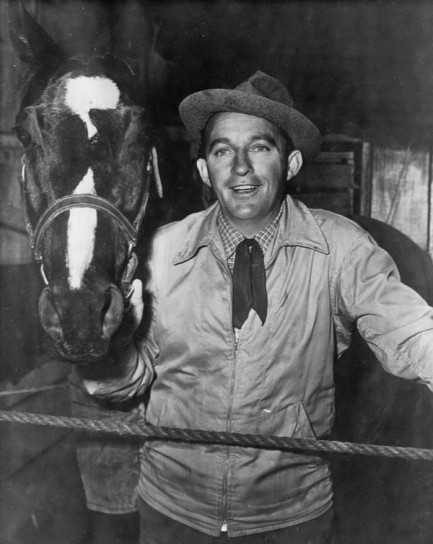 his brother’s book, but Lindsey and Dennis backed Gary’s account. Their suicides by gunshot, six and eight years later, respectively, serve as the debate’s curious exclamation points. But Bing Crosby—whether monstrous abuser or victim of slander—remains an American icon to this day, and books written by other family members portray him as a loving father. As with Governor Faubus, in the end, we may never know what he really was. Both stories prove the old adage true: History depends on who’s doing the telling. his brother’s book, but Lindsey and Dennis backed Gary’s account. Their suicides by gunshot, six and eight years later, respectively, serve as the debate’s curious exclamation points. But Bing Crosby—whether monstrous abuser or victim of slander—remains an American icon to this day, and books written by other family members portray him as a loving father. As with Governor Faubus, in the end, we may never know what he really was. Both stories prove the old adage true: History depends on who’s doing the telling.
 Lili St. Cyr was beloved by legions of fans—the question is whether she loved herself. Today was the day, back in 1999, that the world was deprived of Lili St. Cyr, when she died of heart failure at the age of 80. Her life at the end was quiet—just her and some cats in a modest Hollywood apartment—but during the 1950s she burned up burlesque houses from coast to coast as the most famous, beautiful, and artful exotic dancer in America. She was born in Minneapolis, but her family moved to Pasadena when she was young. Like many girls from her background, she wanted to be a ballet dancer, and her family paid for lessons. When she was eighteen she accompanied her sixteen-year-old sister on a dance interview, and the agency also took a liking to her. Her first job was at Hollywood’s Florentine Gardens, where she was a chorus girl. But the low pay made her determined to headline, even it meant taking off her clothes. Her nude debut was two years later at The Music Box. Supposedly, her act didn’t go well, but the producer stuck with her because he could see quite clearly what everyone else saw as well—she was one of the loveliest girls who ever set foot on his stage. It wasn’t until after adopting the pseudonym Lili St. Cyr over her unusual birth name that her career began to blossom. She scored a job in Montreal at the Gaiety Burlesque House, and worked there for seven years, eventually earning $1500 a week. It was during that time that she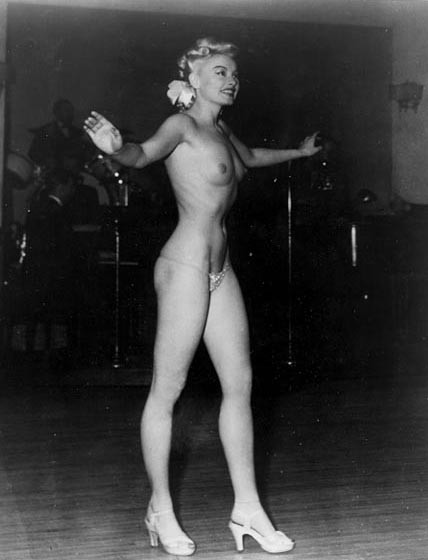 developed some of her trademark techniques, including working with a cockatiel, and having her g-string snatched off by a fishing line that was invisible to the audience. Burlesque crowds were usually raucous, but St. Cyr, with her sheer grace and insistence upon infusing balletic movements into her routines, more often awed audiences into silence. developed some of her trademark techniques, including working with a cockatiel, and having her g-string snatched off by a fishing line that was invisible to the audience. Burlesque crowds were usually raucous, but St. Cyr, with her sheer grace and insistence upon infusing balletic movements into her routines, more often awed audiences into silence. By the end of World War II, St. Cyr was famous enough to travel North America as a headliner. After several years of that she moved back to Hollywood in 1951 to take a headlining gig at Ciro’s. By now she was more than simply Lili St. Cyr—she was The Anatomic Bomb. One of her standard Canadian routines was to perform in a transparent bathtub filled with bubbles. The act didn’t go over quite as well in the U.S., and St. Cyr was hauled into court on obscenity charges. But the arrest was an opportunity, and she used the publicity to further burnish her fame. By the time the jury acquitted her after only 80 minutes of deliberation, all of America knew Lili St. Cyr. At the height of her fame in the mid-1950s, St. Cyr was reportedly earning more than $100,000 a year. With the fame came famous suitors such as Howard Hughes and Vic Damone, but she seems to have married only for love, if one is to judge by the fact that none of her six husbands were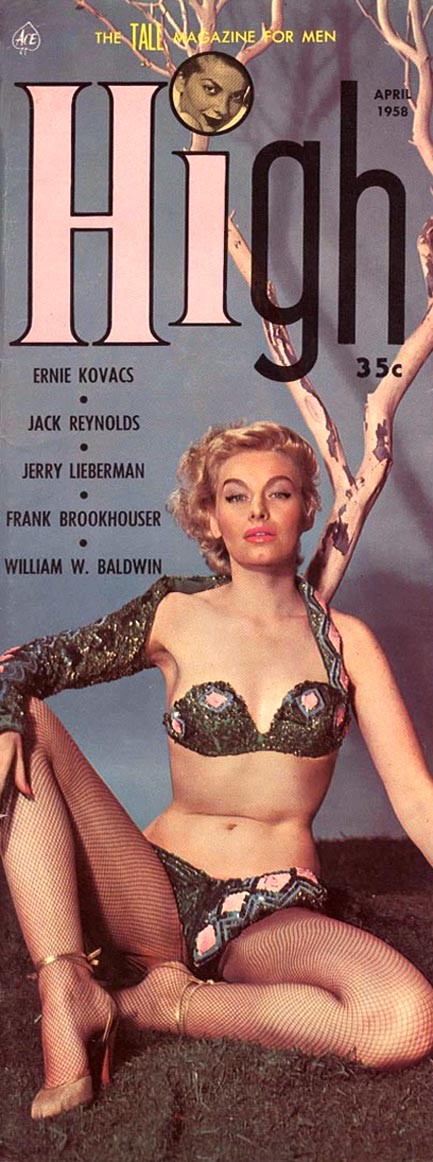 celebrities. With the fame also came the moral watchdogs, those desperate to stop consenting adults from doing what they wished with their own time, and the arrests followed. She was making enough money to afford top legal representation, and she chose the best—Jerry Giesler, who we discussed last June. celebrities. With the fame also came the moral watchdogs, those desperate to stop consenting adults from doing what they wished with their own time, and the arrests followed. She was making enough money to afford top legal representation, and she chose the best—Jerry Giesler, who we discussed last June. Beginning with 1952’s Love Moods, she began to appear in motion pictures, and scored parts in a total of ten, including 1962’s The Naked and the Dead. If that film—which was based upon a Pulitzer Prize-winning Normal Mailer novel—had been a success, St. Cyr might have shifted careers. She had long ago grown tired of burlesque, discussing her desire for a career change as far back as 1957, during a painfully clunky interview with Mike Wallace. But the film was middling, and her performance failed to impress, so she stuck with stripping—the only thing she knew. In 1959 she attempted suicide by taking an overdose of sleeping pills. The trigger was an argument with her boyfriend at the time, but the suicide attempt wasn’t a surprise, considering her many failed marriages and deep ambivalence about her profession. Her personal life had been something of a shambles for years. There were whispers she’d had several abortions, was addicted to pills and dabbling in heroin. The double-edged nature of fame was made abundantly clear when she landed on the front cover of Confidential. Inside were unflattering photos, including a police mugshot. As much as the public loved St. Cyr, it was her enemies that seemed to control the direction of her life. Her legal troubles continued, and another marriage went by the wayside. But St. Cyr was nothing if not persistent. By the time she finally retired from burlesque after thirty years, she had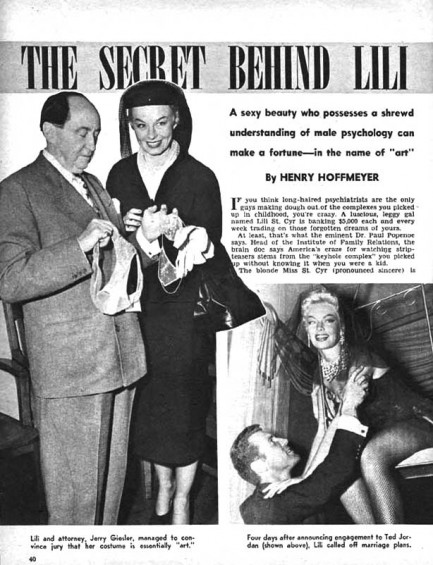 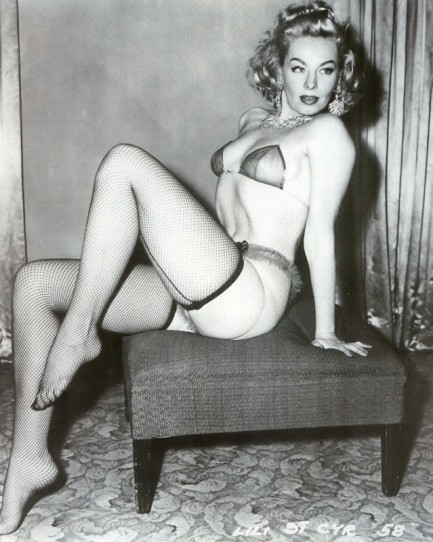 achieved a longstanding goal of establishing herself in another industry by opening a mail order lingerie business similar to Frederick’s of Hollywood. It was called The Undie World of Lili St. Cyr, and her garments were geared toward a male clientele—the idea being that prodding men to give lingerie as gifts was more profitable than trying to appeal to women. St. Cyr was right, and her business became wildly successful, hawking its wares in colorful catalogues that remain collectibles even today. After St. Cyr sold controlling interest in the business, she drifted into a quiet twilight, but, like former nudie queen Bettie Page, experienced a revival during the 1990s. But unlike Page, St. Cyr didn’t appear at conventions and signings—she stayed in her little apartment with her cats. achieved a longstanding goal of establishing herself in another industry by opening a mail order lingerie business similar to Frederick’s of Hollywood. It was called The Undie World of Lili St. Cyr, and her garments were geared toward a male clientele—the idea being that prodding men to give lingerie as gifts was more profitable than trying to appeal to women. St. Cyr was right, and her business became wildly successful, hawking its wares in colorful catalogues that remain collectibles even today. After St. Cyr sold controlling interest in the business, she drifted into a quiet twilight, but, like former nudie queen Bettie Page, experienced a revival during the 1990s. But unlike Page, St. Cyr didn’t appear at conventions and signings—she stayed in her little apartment with her cats.
Most of the sites we visited looking for information on St. Cyr discuss those years of seclusion as if they were an anomaly. But in that 1957 Mike Wallace interview, she confessed that she hated having people look at her. Wallace seemed baffled by this, and for some reason didn’t seem to make the connection that $100,000 a year will go a long way toward helping someone battle stage fright. The idea that she might actually be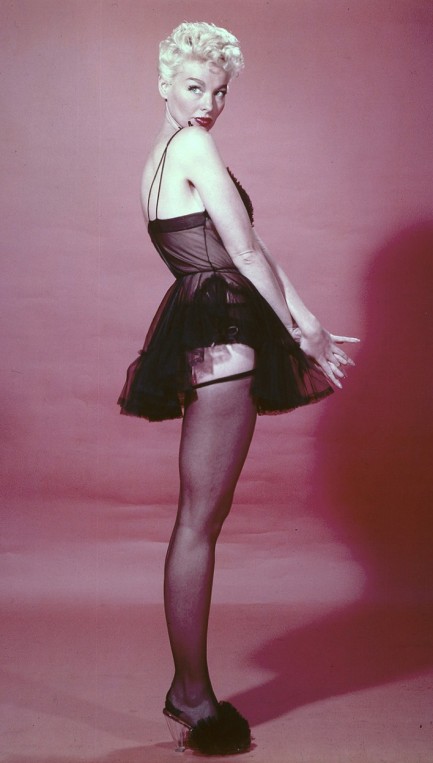 shy instead took him into a line of questioning during which he flat-out said: “You don’t like yourself very much, do you?” And St. Cyr replied, “No, I don’t.” Asked why, she says, “Perhaps because of what I do.” So it seems clear that St. Cyr was always destined to spend her last years avoiding the limelight. And while it’s safe to say the world certainly missed her, it’s equally safe to say that she probably never missed the world. shy instead took him into a line of questioning during which he flat-out said: “You don’t like yourself very much, do you?” And St. Cyr replied, “No, I don’t.” Asked why, she says, “Perhaps because of what I do.” So it seems clear that St. Cyr was always destined to spend her last years avoiding the limelight. And while it’s safe to say the world certainly missed her, it’s equally safe to say that she probably never missed the world.
 No indiscretion was too small for Confidential. 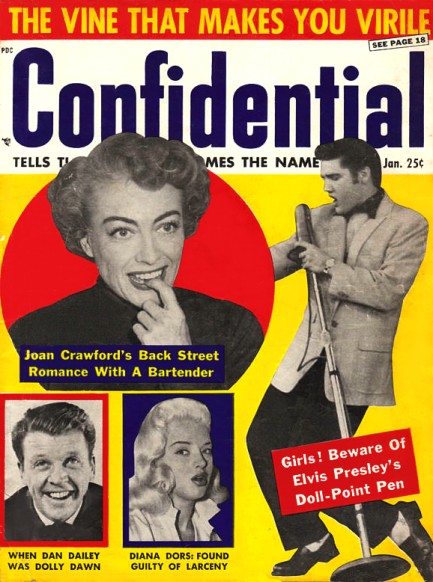
Above is a January 1957 Confidential with Joan Crawford in the spotlight and Elvis in the wings. The Crawford story involves her playing cougar with a boytoy bartender. She’d call, or have an assistant call, and he’d drop everything, scurry over to her house, and be seen leaving the next morning. Pretty salacious claim, but of course, the bartender is never named and so the story is impossible to prove. The Elvis article is in a similar vein. Basically, Presley signed an autograph on a girl’s bare skin, and she ended up going home with him. The next morning the girl called a friend to have the signature photographed before she showered it off. You can get a sense from these two pieces just how extensive Confidential’s network of spies was, and who they were—cabbies, switchboard operators, busboys, mailmen, and doormen. You can also, if you imagine yourself as a movie star, get a sense of how paranoid Hollywood players must have been. Every misstep—no matter how small—was splashed across Confidential’s pages. For a while, the stars simply hoped against hope they could stay under the radar, but eventually they went on the offensive and ran Confidential into the ground with lawsuits. But in 1957, the magazine was still at the height of its power, selling millions of copies and being read secondhand by millions more who were too prim to be seen buying a scandal sheet. Confidential’s actual circulation may have been quadruple its sales figures. Humphrey Bogart said it best: “Everybody reads it but they say the cook brought it into the house.” 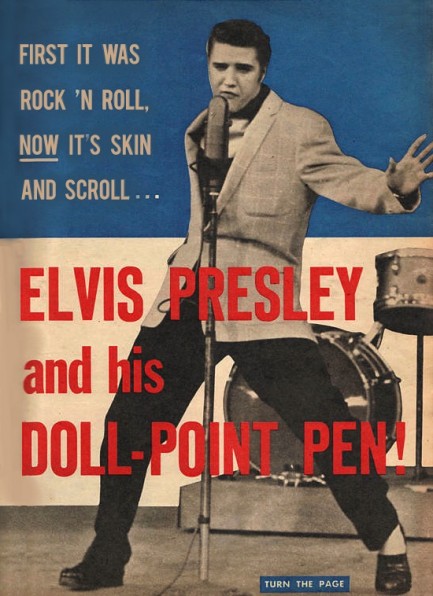 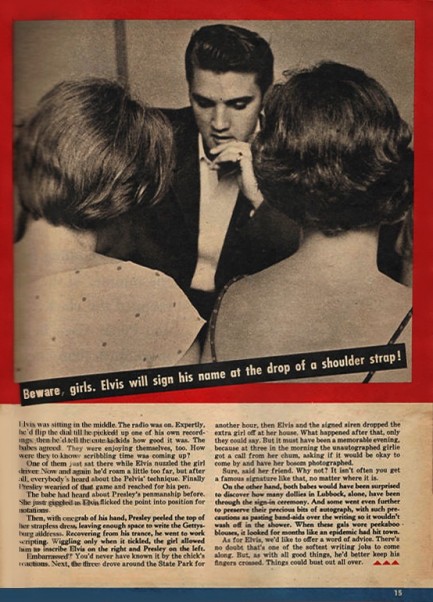
 In 1962 Hollywood actresses began showing skin for the first time in more than thirty years. Today we have a Confidential from October 1962, featuring a rundown of nude scenes by the biggest actresses of the time. The Natalie Wood shot in the little collage they’ve put together is from Gypsy, her biopic of the stripper Gypsy Rose Lee, where she showed her back, but did not in fact appear nude. Likewise, Liz Taylor never appeared nude in a film. Ditto Kim Novak, although she posed quite provocatively for many photographers, including wearing only soapsuds in a Life magazine bio, and in a rumored set of explicit youthful nudes. You can find those on the trusty interweb, but the identity of the woman in the shots is certainly open to debate. Jayne Mansfield and Marilyn Monroe were two entirely different cases, though. The Mansfield image above is from 1962’s It Happened in Athens, in which she went skimpy, but not naked. But the next year she went fully topless in Promises! Promises! and triggered a national firestorm, including a ban of the film in several cities. She was the first mainstream American actress to go topless, not counting the several who bared it before the introduction of the Hayes Code back in 1930. In late 1963, Promises! Promises! stills were featured in Playboy, and those too caused a problem, because they showed that Mansfield had actually been fully nude on the set. An obscenity trial for Hugh Hefner followed, but he was acquitted. In any case, Promises! Promises! was a hit. It wasn’t a very good film. But the scenes with Mansfield are indeed extraordinarily sexy. The Monroe story is equally fascinating. When she was making the film Something’s Got To Give, she was supposed to appear in a swimming scene wearing the usual flesh-colored body stocking to conceal her lady parts. Monroe had caused problems on many sets by then, and her reputation was in tatters. When the time came to shoot the scene, she allegedly did it fully nude, with publicity photographers and crew present.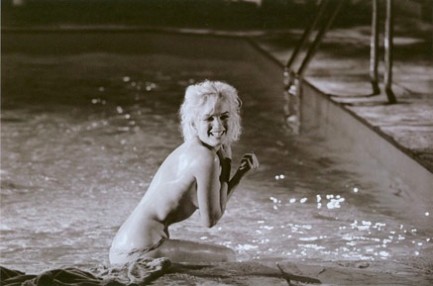 The event caused a sensation, and seemed to signal a renewed focus from Marilyn to reclaim her status as America’s top sex symbol. Sadly, it was the last splash she ever made—she was fired and the film was never finished. But a precedent had been reestablished—for the first time since the Hayes Code, actresses were showing skin. Soon, Hollywood males would be doing the same. In less than a decade the human body would be fully uncovered on film, and there was no putting it back under wraps. The event caused a sensation, and seemed to signal a renewed focus from Marilyn to reclaim her status as America’s top sex symbol. Sadly, it was the last splash she ever made—she was fired and the film was never finished. But a precedent had been reestablished—for the first time since the Hayes Code, actresses were showing skin. Soon, Hollywood males would be doing the same. In less than a decade the human body would be fully uncovered on film, and there was no putting it back under wraps.
 He had a lot in common with the guy on those Dos Equis commercials, except he was real. 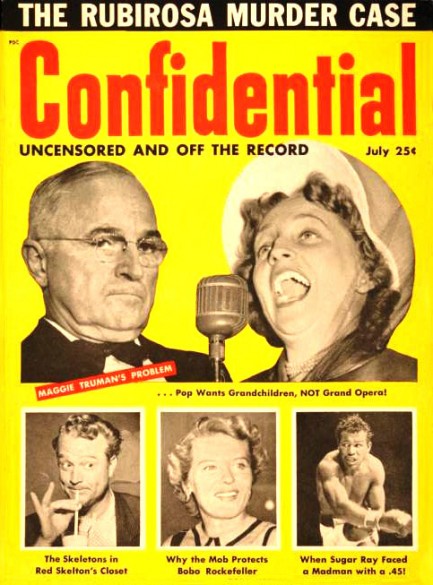 Today we’re back to the top dog of classic tabloids, the always-titillating Confidential. The above issue is from fifty-five years ago this month, July 1954, and as always the cover promises scandalous inside scoop—this time on champs, presidents, and filthy rich heiresses. But it’s the unassuming banner on the Rubirosa murder case that interests us, because it refers to none other than Porfirio Rubirosa, and if you’ve never heard of him, then prepare yourself to meet (cue grandiose flamenco chords) The Most Interesting Man in the World. Today we’re back to the top dog of classic tabloids, the always-titillating Confidential. The above issue is from fifty-five years ago this month, July 1954, and as always the cover promises scandalous inside scoop—this time on champs, presidents, and filthy rich heiresses. But it’s the unassuming banner on the Rubirosa murder case that interests us, because it refers to none other than Porfirio Rubirosa, and if you’ve never heard of him, then prepare yourself to meet (cue grandiose flamenco chords) The Most Interesting Man in the World. Rubirosa was born in the Dominican Republic in 1909 but raised in France, where his father, an army general, had scored the chargé d'affaires position at the Dominican consulate in Paris. When the young Rubirosa was seventeen he returned to the Dominican to study law, but enlisted in the military before finishing. In 1932, after a weeklong courtship, he married a seventeen year-old girl named Flor de Oro Trujillo, who happened to be the daughter of mass-murdering military dictator Rafael Leónidas Trujillo Molina. For normal men, rush-marrying a dictator’s little flower would result in a one-way ticket to the torture chamber, but for the charming Rubirosa it meant a diplomatic post in Berlin. In 1935, Rubirosa’s cousin, Luis de la Fuente Rubirosa, was accused of assassinating exiled Dominican politician Sergio Bencosme in New York City. It was Rafael Trujillo’s work, but de la Fuente Rubirosa was the triggerman, and Porifirio was suspected of being an accomplice. That’s the murder Confidential references, and if you’re asking yourself why they cared about it nineteen years after the event, it’s because by then Rubirosa was very famous. But we’ll get to that.  Rubirosa had developed passions for polo, racing, gambling, and other expensive upper crust pursuits. He excelled at all of them. Perhaps the only thing he wasn’t good at was fidelity, which led to his divorce from Flor in 1937. But his sheer magnetism—or perhaps the fact that he was a valuable hired gun—kept him in dictator dad’s good graces, and he continued to receive diplomatic posts. When World War II swept across Europe, Rubirosa made a stack of money selling Dominican exit visas to fleeing Jews. At some point the Gestapo imprisoned him, but he was released after six months. After that, he was allegedly recruited as a political assassin. Rubirosa had developed passions for polo, racing, gambling, and other expensive upper crust pursuits. He excelled at all of them. Perhaps the only thing he wasn’t good at was fidelity, which led to his divorce from Flor in 1937. But his sheer magnetism—or perhaps the fact that he was a valuable hired gun—kept him in dictator dad’s good graces, and he continued to receive diplomatic posts. When World War II swept across Europe, Rubirosa made a stack of money selling Dominican exit visas to fleeing Jews. At some point the Gestapo imprisoned him, but he was released after six months. After that, he was allegedly recruited as a political assassin. In 1942 he met and married the French actress Danielle Darrieux, who you see above. From then on Rubirosa traveled in cinematic circles, which meant a more public profile. A consequence of this was that tidbits of his personal life began to leak out. Suddenly everyone knew he was a great lover, and that he had a penis measuring anywhere from eleven to fourteen inches, depending on whom you believed. After a while the slang term “rubirosa” became popular in France. They used it to refer to the giant pepper grinders in restaurants, and still do to this day. By now there were open questions about Rubirosa’s racial background. He was very dark, and was often described as “nut brown.” Rumors spread that he was part black—a devastating accusation in the 1940s, and one still used very effectively as a smear even in today’s supposedly post-racial age. But Rubirosa handled the gossip with the panache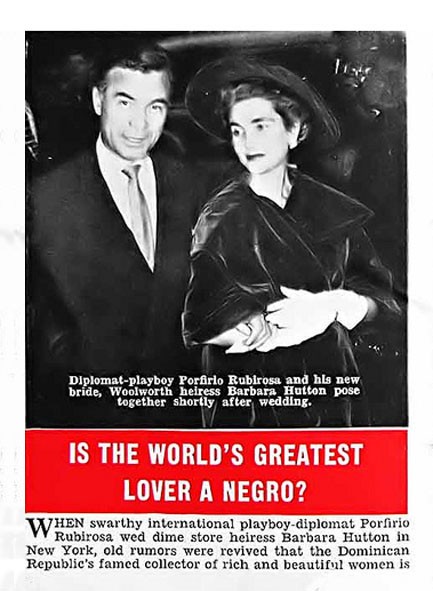 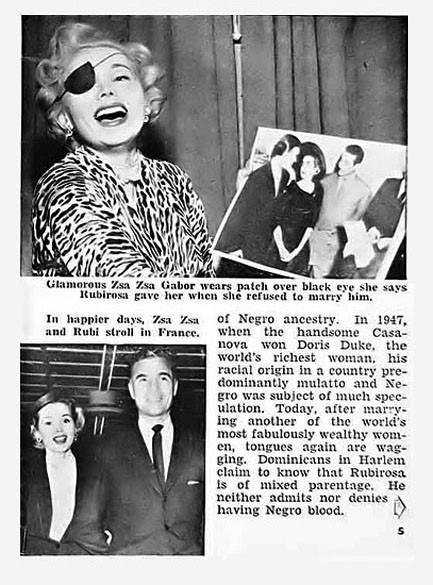 you'd expect from The Most Interesting Man in the World—he never addressed it all, at least not in public. His silence basically amounted to: “So what if I am?” And if the rumors bothered him, he surely derived ample compensation from the fact that legions of female admirers who’d heard about that pepper grinder of his didn’t care. you'd expect from The Most Interesting Man in the World—he never addressed it all, at least not in public. His silence basically amounted to: “So what if I am?” And if the rumors bothered him, he surely derived ample compensation from the fact that legions of female admirers who’d heard about that pepper grinder of his didn’t care. Because of the ease with which he was able to meet and bed women, Rubirosa found it impossible to remain faithful, even to an elegant beauty like Danielle Darrieux. They divorced in 1947, and the high-profile involvements began to pile up. There was Dolores del Rio, Ava Gardner, Rita Hayworth, Soraya Esfandiary, Veronica Lake, Kim Novak, Doris Duke (who happened to be the richest woman in the world), and Barbara Hutton (who was the second richest woman in the world). He fooled around with his first love Flor during his marriage to Duke, and with Zsa Zsa Gabor during his marriage to Hutton. When Duke divorced him he walked with $500,000, a string of polo ponies, some sports cars, a converted B-25 bomber, and a 17th century house in Paris. When Hutton divorced him—after only five weeks—he added a coffee plantation in the Dominican, another B-25, and $3.5 million to his holdings. By now he was a professional celebrity. He was friendly with Joe Kennedy, Frank Sinatra, and Sammy Davis, Jr. One night in Paris, after teaching Davis how to properly kiss a woman's hand, the two went out to perfect the technique by flirting with women on the Champs-Élysées. Frank Sinatra once asked Rubirosa, “Rubi, have you ever held a full-time job?” Rubirosa reportedly answered, “Women are my full-time job.” At some point he met Ian Fleming, and the novice writer came up with the great idea of basing a character on Rubirosa—a certain spy named James Bond. job?” Rubirosa reportedly answered, “Women are my full-time job.” At some point he met Ian Fleming, and the novice writer came up with the great idea of basing a character on Rubirosa—a certain spy named James Bond. Rubirosa’s fame made him tabloid fodder, and the scandal sheets dutifully tried to dig up dirt on him. They went back to the racial stuff, and whispered about that nineteen year-old New York murder. But the rumors that he had been an assassin just fed into his growing legend. He seemed to know everything, was one of the boys, one with the girls, and had already done more than most men manage in a lifetime. Truman Capote saw Rubirosa’s cock and rated it eleven inches. A female acquaintance pointed out a size twelve loafer in a shoe store and said Rubi had it beat. Rubirosa partied his way from Hollywood to Rome to Monaco, and wherever he went local women hung around his favorite hotels and bars, hoping to meet him. He was racing his Ferrari professionally, and competed twice in the 24-hour race at LeMans. He was also looking for a relationship that would last, and in 1956 he married for the fifth time to actress Odile Rodin. She was nineteen and he was 42. He had mellowed—not a lot—but just enough to remain faithful. The marriage seemed to work. He was still boyish and exciting, and his biggest asset—that famous pepper grinder—showed no signs of diminishing with age. He began working on his memoirs. He was still young for that, but he had lived so much. In 1965 Rubirosa was part of a team that won the Coupe de France polo cup. He spent the night of the victory celebrating at a Paris nightspot called Jimmy’s, then headed home in his Ferrari. The roads were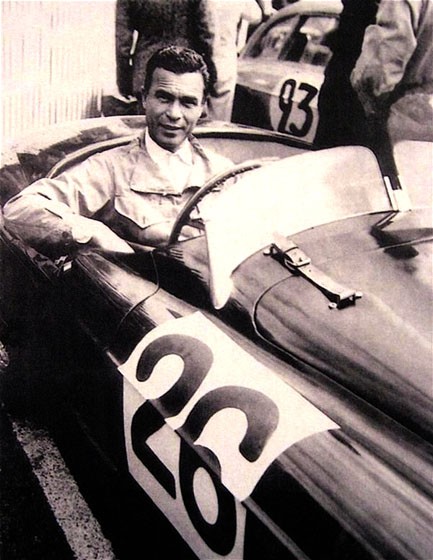 wet, and he was a little drunk. He lost control of the car and died in a fiery crash. The Most Interesting Man in the World was gone—literally burning out rather than fading away. He never finished his memoirs, and today the closest the world has to a Porfirio Rubirosa is a fictional character in a Dos Equis commercial. wet, and he was a little drunk. He lost control of the car and died in a fiery crash. The Most Interesting Man in the World was gone—literally burning out rather than fading away. He never finished his memoirs, and today the closest the world has to a Porfirio Rubirosa is a fictional character in a Dos Equis commercial. More than almost any man of his era, Porfirio Rubirosa represents the lost glamour and mystery of a time that can never be reclaimed. He was the product of a more innocent and refined—yet also crueler—age. Reading about his life is like reading about an event you’d give anything to have witnessed, even if it would have been dangerous to be there. Rumor has it a few Rubirosa-based scripts are floating around Hollywood. Supposedly Antonio Banderas has rights to one, and wants to play the lead role. Maybe it’s a lack of imagination on our part, but we don’t see it. There is no shortage of legends in history, but we can’t think of one whose shoes would be more difficult to fill. As much as we’d like to see a Rubirosa biopic, our advice is this: if it’s better to burn out than to fade away, maybe it’s also better to never try and rekindle the flame.
 |  |
|
 |

The headlines that mattered yesteryear.
1918—U.S. Congress Passes the Sedition Act
In the U.S., Congress passes a set of amendments to the Espionage Act called the Sedition Act, which makes "disloyal, profane, scurrilous, or abusive language" about the United States government, its flag, or its armed forces, as well as language that causes foreigners to view the American government or its institutions with contempt, an imprisonable offense. The Act specifically applies only during times of war, but later is pushed by politicians as a possible peacetime law, specifically to prevent political uprisings in African-American communities. But the Act is never extended and is repealed entirely in 1920. 1905—Las Vegas Is Founded
Las Vegas, Nevada is founded when 110 acres of barren desert land in what had once been part of Mexico are auctioned off to various buyers. The area sold is located in what later would become the downtown section of the city. From these humble beginnings Vegas becomes the most populous city in Nevada, an internationally renowned resort for gambling, shopping, fine dining and sporting events, as well as a symbol of American excess. Today Las Vegas remains one of the fastest growing municipalities in the United States. 1928—Mickey Mouse Premieres
The animated character Mickey Mouse, along with the female mouse Minnie, premiere in the cartoon Plane Crazy, a short co-directed by Walt Disney and Ub Iwerks. This first cartoon was poorly received, however Mickey would eventually go on to become a smash success, as well as the most recognized symbol of the Disney empire. 1939—Five-Year Old Girl Gives Birth
In Peru, five-year old Lina Medina becomes the world's youngest confirmed mother at the age of five when she gives birth to a boy via a caesarean section necessitated by her small pelvis. Six weeks earlier, Medina had been brought to the hospital because her parents were concerned about her increasing abdominal size. Doctors originally thought she had a tumor, but soon determined she was in her seventh month of pregnancy. Her son is born underweight but healthy, however the identity of the father and the circumstances of Medina's impregnation never become public. 1987—Rita Hayworth Dies
American film actress and dancer Margarita Carmen Cansino, aka Rita Hayworth, who became her era's greatest sex symbol and appeared in sixty-one films, including the iconic Gilda, dies of Alzheimer's disease in her Manhattan apartment. Naturally shy, Hayworth was the antithesis of the characters she played. She married five times, but none lasted. In the end, she lived alone, cared for by her daughter who lived next door. |

|
|

It's easy. We have an uploader that makes it a snap. Use it to submit your art, text, header, and subhead. Your post can be funny, serious, or anything in between, as long as it's vintage pulp. You'll get a byline and experience the fleeting pride of free authorship. We'll edit your post for typos, but the rest is up to you. Click here to give us your best shot.

|
|














 Her fame was a controversial subject of course, if not a public obsession, and her marriages caused epic scandals, but also prompted the French government to legalize unions between transgendered participants. By 1989 Coccinelle had moved to Marseilles, where she headlined at the Cabaret Spitz. She was still performing there in April 2006 when she had a stroke. She died after three months of hospitalization, but over forty years she had carved out a successful career, made a difference politically and, at the forefront of her own small sexual revolution, helped scores of people in her exact circumstances. We’ll look for more information on the fascinating Coccinelle at our usual French sources and perhaps report back on her later.
Her fame was a controversial subject of course, if not a public obsession, and her marriages caused epic scandals, but also prompted the French government to legalize unions between transgendered participants. By 1989 Coccinelle had moved to Marseilles, where she headlined at the Cabaret Spitz. She was still performing there in April 2006 when she had a stroke. She died after three months of hospitalization, but over forty years she had carved out a successful career, made a difference politically and, at the forefront of her own small sexual revolution, helped scores of people in her exact circumstances. We’ll look for more information on the fascinating Coccinelle at our usual French sources and perhaps report back on her later. 
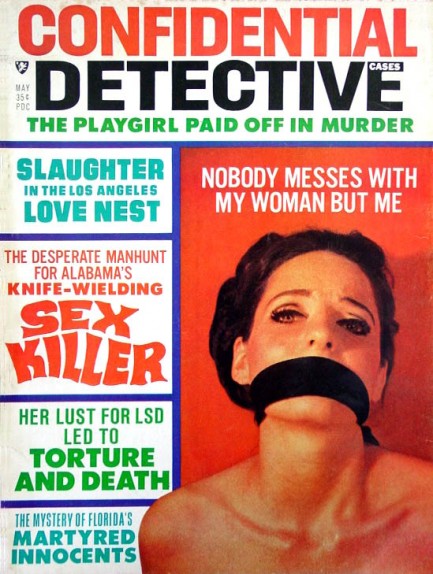


 celebrated society hostess in the world. The worst Maxwell probably ever did was dish on society types in her gossip column; Getty once allowed kidnappers to cut off his grandson’s ear rather than part with a ransom, and once extended to Alfried Krupp von Bohlen—a German munitions baron who had given lavishly to the Nazi Party, used Jewish slaves in his industries during WWII, and allowed his factory yards to be used for executing POWs—an invitation to his house warming party. Advantage, Maxwell. One other thing in her favor—she’s the person the phrase “the hostess with the mostest” was popularized about. We’d take that as a legacy any day.
celebrated society hostess in the world. The worst Maxwell probably ever did was dish on society types in her gossip column; Getty once allowed kidnappers to cut off his grandson’s ear rather than part with a ransom, and once extended to Alfried Krupp von Bohlen—a German munitions baron who had given lavishly to the Nazi Party, used Jewish slaves in his industries during WWII, and allowed his factory yards to be used for executing POWs—an invitation to his house warming party. Advantage, Maxwell. One other thing in her favor—she’s the person the phrase “the hostess with the mostest” was popularized about. We’d take that as a legacy any day.

 end of the war, and we doubt any exists. But it’s true that minority participation and casualties fell as the conflict progressed—though the numbers didn’t shift as radically as many people think.
end of the war, and we doubt any exists. But it’s true that minority participation and casualties fell as the conflict progressed—though the numbers didn’t shift as radically as many people think.

 of whether he did it to prevent white mobs from taking violent action against black kids, since he had allegedly been convinced violence was imminent. And it could be argued that if his ultra rightwing rival had defeated him Arkansas would have been far worse off.
of whether he did it to prevent white mobs from taking violent action against black kids, since he had allegedly been convinced violence was imminent. And it could be argued that if his ultra rightwing rival had defeated him Arkansas would have been far worse off. his brother’s book, but Lindsey and Dennis backed Gary’s account. Their suicides by gunshot, six and eight years later, respectively, serve as the debate’s curious exclamation points. But Bing Crosby—whether monstrous abuser or victim of slander—remains an American icon to this day, and books written by other family members portray him as a loving father. As with Governor Faubus, in the end, we may never know what he really was. Both stories prove the old adage true: History depends on who’s doing the telling.
his brother’s book, but Lindsey and Dennis backed Gary’s account. Their suicides by gunshot, six and eight years later, respectively, serve as the debate’s curious exclamation points. But Bing Crosby—whether monstrous abuser or victim of slander—remains an American icon to this day, and books written by other family members portray him as a loving father. As with Governor Faubus, in the end, we may never know what he really was. Both stories prove the old adage true: History depends on who’s doing the telling.
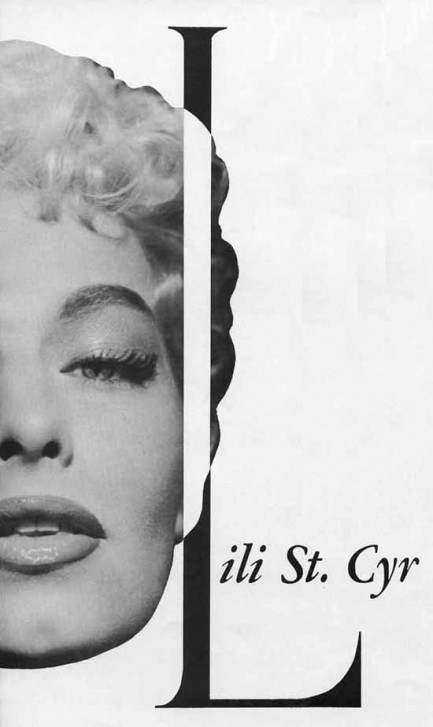
 developed some of her trademark techniques, including working with a cockatiel, and having her g-string snatched off by a fishing line that was invisible to the audience. Burlesque crowds were usually raucous, but St. Cyr, with her sheer grace and insistence upon infusing balletic movements into her routines, more often awed audiences into silence.
developed some of her trademark techniques, including working with a cockatiel, and having her g-string snatched off by a fishing line that was invisible to the audience. Burlesque crowds were usually raucous, but St. Cyr, with her sheer grace and insistence upon infusing balletic movements into her routines, more often awed audiences into silence. celebrities. With the fame also came the moral watchdogs, those desperate to stop consenting adults from doing what they wished with their own time, and the arrests followed. She was making enough money to afford top legal representation, and she chose the best—Jerry Giesler, who we discussed last June.
celebrities. With the fame also came the moral watchdogs, those desperate to stop consenting adults from doing what they wished with their own time, and the arrests followed. She was making enough money to afford top legal representation, and she chose the best—Jerry Giesler, who we discussed last June.
 achieved a longstanding goal of establishing herself in another industry by opening a mail order lingerie business similar to Frederick’s of Hollywood. It was called The Undie World of Lili St. Cyr, and her garments were geared toward a male clientele—the idea being that prodding men to give lingerie as gifts was more profitable than trying to appeal to women. St. Cyr was right, and her business became wildly successful, hawking its wares in colorful catalogues that remain collectibles even today. After St. Cyr sold controlling interest in the business, she drifted into a quiet twilight, but, like former nudie queen Bettie Page, experienced a revival during the 1990s. But unlike Page, St. Cyr didn’t appear at conventions and signings—she stayed in her little apartment with her cats.
achieved a longstanding goal of establishing herself in another industry by opening a mail order lingerie business similar to Frederick’s of Hollywood. It was called The Undie World of Lili St. Cyr, and her garments were geared toward a male clientele—the idea being that prodding men to give lingerie as gifts was more profitable than trying to appeal to women. St. Cyr was right, and her business became wildly successful, hawking its wares in colorful catalogues that remain collectibles even today. After St. Cyr sold controlling interest in the business, she drifted into a quiet twilight, but, like former nudie queen Bettie Page, experienced a revival during the 1990s. But unlike Page, St. Cyr didn’t appear at conventions and signings—she stayed in her little apartment with her cats. shy instead took him into a line of questioning during which he flat-out said: “You don’t like yourself very much, do you?” And St. Cyr replied, “No, I don’t.” Asked why, she says, “Perhaps because of what I do.” So it seems clear that St. Cyr was always destined to spend her last years avoiding the limelight. And while it’s safe to say the world certainly missed her, it’s equally safe to say that she probably never missed the world.
shy instead took him into a line of questioning during which he flat-out said: “You don’t like yourself very much, do you?” And St. Cyr replied, “No, I don’t.” Asked why, she says, “Perhaps because of what I do.” So it seems clear that St. Cyr was always destined to spend her last years avoiding the limelight. And while it’s safe to say the world certainly missed her, it’s equally safe to say that she probably never missed the world. 




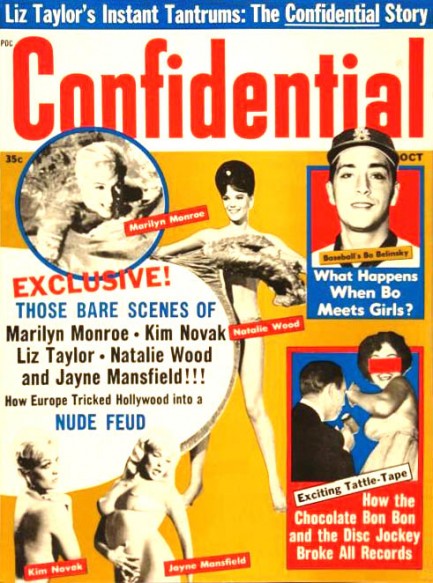
 The event caused a sensation, and seemed to signal a renewed focus from Marilyn to reclaim her status as America’s top sex symbol. Sadly, it was the last splash she ever made—she was fired and the film was never finished. But a precedent had been reestablished—for the first time since the Hayes Code, actresses were showing skin. Soon, Hollywood males would be doing the same. In less than a decade the human body would be fully uncovered on film, and there was no putting it back under wraps.
The event caused a sensation, and seemed to signal a renewed focus from Marilyn to reclaim her status as America’s top sex symbol. Sadly, it was the last splash she ever made—she was fired and the film was never finished. But a precedent had been reestablished—for the first time since the Hayes Code, actresses were showing skin. Soon, Hollywood males would be doing the same. In less than a decade the human body would be fully uncovered on film, and there was no putting it back under wraps. 
 Today we’re back to the top dog of classic tabloids, the always-titillating Confidential. The above issue is from fifty-five years ago this month, July 1954, and as always the cover promises scandalous inside scoop—this time on champs, presidents, and filthy rich heiresses. But it’s the unassuming banner on the Rubirosa murder case that interests us, because it refers to none other than Porfirio Rubirosa, and if you’ve never heard of him, then prepare yourself to meet (cue grandiose flamenco chords) The Most Interesting Man in the World.
Today we’re back to the top dog of classic tabloids, the always-titillating Confidential. The above issue is from fifty-five years ago this month, July 1954, and as always the cover promises scandalous inside scoop—this time on champs, presidents, and filthy rich heiresses. But it’s the unassuming banner on the Rubirosa murder case that interests us, because it refers to none other than Porfirio Rubirosa, and if you’ve never heard of him, then prepare yourself to meet (cue grandiose flamenco chords) The Most Interesting Man in the World. Rubirosa had developed passions for polo, racing, gambling, and other expensive upper crust pursuits. He excelled at all of them. Perhaps the only thing he wasn’t good at was fidelity, which led to his divorce from Flor in 1937. But his sheer magnetism—or perhaps the fact that he was a valuable hired gun—kept him in dictator dad’s good graces, and he continued to receive diplomatic posts. When World War II swept across Europe, Rubirosa made a stack of money selling Dominican exit visas to fleeing Jews. At some point the Gestapo imprisoned him, but he was released after six months. After that, he was allegedly recruited as a political assassin.
Rubirosa had developed passions for polo, racing, gambling, and other expensive upper crust pursuits. He excelled at all of them. Perhaps the only thing he wasn’t good at was fidelity, which led to his divorce from Flor in 1937. But his sheer magnetism—or perhaps the fact that he was a valuable hired gun—kept him in dictator dad’s good graces, and he continued to receive diplomatic posts. When World War II swept across Europe, Rubirosa made a stack of money selling Dominican exit visas to fleeing Jews. At some point the Gestapo imprisoned him, but he was released after six months. After that, he was allegedly recruited as a political assassin.
 you'd expect from The Most Interesting Man in the World—he never addressed it all, at least not in public. His silence basically amounted to: “So what if I am?” And if the rumors bothered him, he surely derived ample compensation from the fact that legions of female admirers who’d heard about that pepper grinder of his didn’t care.
you'd expect from The Most Interesting Man in the World—he never addressed it all, at least not in public. His silence basically amounted to: “So what if I am?” And if the rumors bothered him, he surely derived ample compensation from the fact that legions of female admirers who’d heard about that pepper grinder of his didn’t care. job?” Rubirosa reportedly answered, “Women are my full-time job.” At some point he met Ian Fleming, and the novice writer came up with the great idea of basing a character on Rubirosa—a certain spy named James Bond.
job?” Rubirosa reportedly answered, “Women are my full-time job.” At some point he met Ian Fleming, and the novice writer came up with the great idea of basing a character on Rubirosa—a certain spy named James Bond. wet, and he was a little drunk. He lost control of the car and died in a fiery crash. The Most Interesting Man in the World was gone—literally burning out rather than fading away. He never finished his memoirs, and today the closest the world has to a Porfirio Rubirosa is a fictional character in a Dos Equis commercial.
wet, and he was a little drunk. He lost control of the car and died in a fiery crash. The Most Interesting Man in the World was gone—literally burning out rather than fading away. He never finished his memoirs, and today the closest the world has to a Porfirio Rubirosa is a fictional character in a Dos Equis commercial.





































































